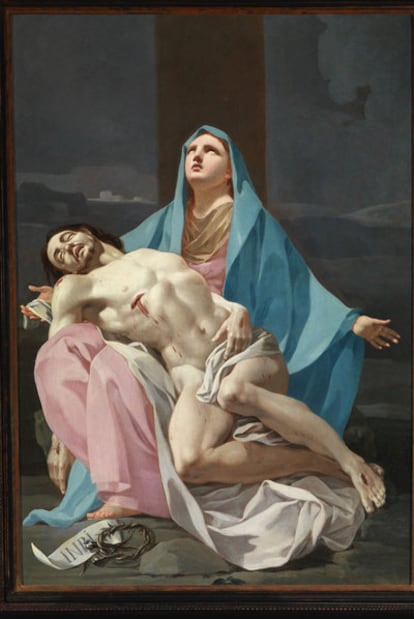New controversy over Goya attribution
A specialist contends that a 1774 painting of a sorrowful Mary, thought to be the work of Francisco Bayeu, was in fact painted by his gifted pupil from Zaragoza at the age of 28
In the passion-filled world of art attributions, where experts tread with care and personal prestige is often on the line, Goya is a genre unto himself. With the controversy over The Colossus still smoldering - in 2008 its authorship was transferred to Asensio Juliá - art experts are ending the year with a new topic of debate.
The prestigious specialist Arturo Ansón Navarro believes he has found a new Goya. The artwork in question is a Pietà painted around 1774, which the Aragonese genius allegedly completed at age 28. It is a painting that may surprise the uninitiated, but which contains all the elements that would ultimately define Goya's more mature art.
The specialized magazine Ars, which last summer unveiled the by now famous "Yale Velázquez" (La educación de la virgen), this week published a study about this delicate Pietà, which belongs to a Catalan collector. Until now, the painting had been attributed to Francisco Bayeu, another artist from Zaragoza. The oil, measuring 83.5cm by 58cm, is in pristine condition and was purchased by its current owner in 2008.
Other experts are being prudent with their initial reactions, choosing to wait until they become more familiar with the artwork. Ismael Gutiérrez Pastor, a professor at Autónoma University in Madrid, has already viewed it personally and harbors no doubts over its being an authentic Goya.
Over at the Prado Museum, Manuela Mena, the chief curator of 18th-century art (and famous for her brave disattribution of The Colossus) declined to make any comments. Another specialist, who wanted to remain anonymous, downplayed the importance of the discovery, because even in the best of cases, it would be a painting "from when Goya wasn't yet Goya."
As is often the case, the finding happened almost by chance. Professor Ansón Navarro explains that he first came into contact with the artwork in June 2008. "It had just been purchased from the heirs of a collector from Zaragoza, and its new owner, thinking it was by Francisco Bayeu, asked me to confirm it. I immediately realized that this was not a Bayeu but a surprising piece by Goya from his Zaragoza period."
"I remember closely analyzing all the details in the painting, whose beauty I found astounding," Ansón Navarro recalls. "The paint was a bit dirty, the varnish was aging, but otherwise it was untouched, perfect, just the way Goya left it. I couldn't believe my eyes. I thought it was a ravishing piece of art. After about five minutes of silence, which must have seemed endless to the two people who brought me the painting, the owner asked me in a disconcerted tone: 'Isn't it a Bayeu?' And I immediately replied: 'No, it's not a Bayeu; it's a Goya."
Ansón Navarro believes the painting had stayeed in Zaragoza all this time. "Goya probably painted this sorrowful Virgin Mary for an individual from Zaragoza. We know that in the mid-20th century it belonged to a canon from the Chapter of Zaragoza, and that it was purchased by a leading collector from that city. When this man died a few years ago, his heirs split up his collection, and it was one of these heirs who sold the Pietà in 2008 to its current owner, who is from Barcelona".
Although he is treading on slippery terrain, Ansón Navarro does not hesitate to offer a clear opinion: "I have no doubts about this Pietá. I have spent over 30 years researching Spanish and Aragonese painting from the 18th century. I wrote my dissertation on the painter José Luzán, who was Goya's first master. I have curated two monograph exhibitions on Francisco Bayeu, Goya's brother-in-law and second master. Right now I am completing a book about the Bayeus."
Although he knows his assertion will cause some reticence, the professor believes "we need to keep studying Goya's work rigorously, without sensationalism [...] The better we investigate, the better results we will obtain and Goya's oeuvre will benefit."
But how does one go about establishing the true author of a work of art? Manuela Mena says there is one clear starting point: "Thirty years of study and preparation. A university professor can spend a lifetime working with what others have written, and that's all right. But at museums it is your obligation to have the ability to analyze an artwork and know whether it is true art or not, because it is part of the state's heritage and the state needs to know what it has," she explains.
Gabriele Finaldi, chief curator at El Prado, agrees. "You have to be able to tell an excellent painting from a lesser one. From there on you work to identify the specific hand that painted it."
Many experts resort to the Morellian technique (named after Giovanni Morelli), which entails looking out for specific characteristics in less obvious places, such as earlobes or fingernails in the case of human depictions.
The real problem, everyone agrees, is when the work in question is of mediocre quality. "The frontiers become blurry, and the personal touch less recognizable," says Mena.
Technologies such as infrared and X-rays can provide evidence of corrections made to the painting before it was finished. If there are none, and the execution is perfect, it is more likely to be an imitation or a copy, perhaps by the author himself. Pigment analysis can also help, but Mena cannot recall a single case in which technique contradicted the hypothesis formulated through expert knowledge.








































